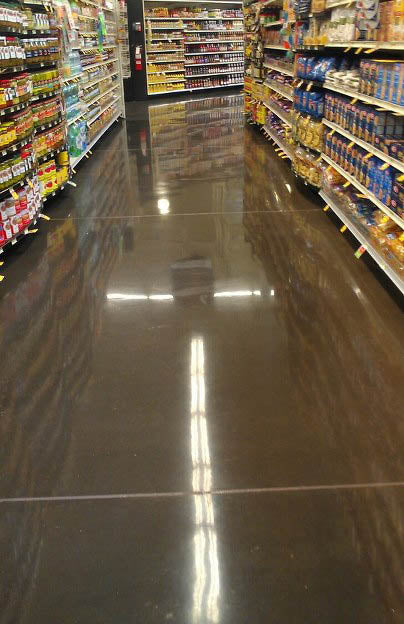
5 Benefits of Diamond Tools When Polishing Concrete
Share
Polished concrete floors require two main elements — a polished concrete filler and a polisher. The purpose of the concrete filler is to fill in the pores of a concrete surface with a polymer. This polymer filler hardens the concrete surface and protects it from stains and abrasions.
The purpose of the polisher is to grind the concrete to a smooth and shiny surface and work the concrete filler into the concrete. In a typical polishing process, grinding tools of progressively finer grit are used to achieve the final result. Technically speaking, concrete is considered polished when the grinding tool exceeds 400 grit.
There are two different types of tools used to grind concrete. Metal bond diamond abrasive is formed by sintering synthetic industrial diamonds and metal powder. Resin diamond abrasive is formed by mixing plastic resin with synthetic industrial diamonds and compressing it. In both cases, the resulting tool is a solid metal or resin bond with diamonds embedded inside.
The plastic used to make resin diamond abrasive tools is not a soft plastic like those used to make milk jugs or toys. Rather, the resin in resin diamond abrasive tools is the same hard and durable resin used to make billiard balls.
There are many reasons polishers use industrial diamonds in the grinding tools. Here are five benefits of diamond tools when polishing concrete:
Hardness
Diamonds, coal, and graphite have the same chemical makeup. In coal and graphite, the carbon atoms are arranged in sheets. This gives coal and graphite its soft texture. Diamonds, conversely, are a crystalline form of carbon.
In diamonds the carbon atoms are arranged in a tetrahedron. This arrangement means that each carbon atom is bonded to five other carbon atoms in three-dimensional space. This is much stronger than the carbon sheets in graphite and coal. In fact, this molecular arrangement makes diamonds so hard that diamonds can cut every other material, including other diamonds.
Concrete is a blend of cement, water, and aggregate in the form of sand or gravel. The cement undergoes a chemical reaction in the presence of water and binds the aggregate into a rock-like form. The resulting concrete is a hardened mixture primarily made up of sand or gravel, calcium silicates, and other calcium compounds.
Diamonds are ideal for grinding concrete because, as the recipe for concrete makes clear, it is impossible to identify every component in concrete. Therefore, tools for working cured concrete must be capable of cutting every type of chemical compound, including the rocks that make up the gravel. Hypothetically speaking, concrete could even include diamonds and a metal bond diamond abrasive or resin diamond abrasive and diamonds would still be hard enough to polish it.
Durability
Because of their hardness, diamonds are forever, just as the song says. As a result, diamond tools are more durable than all other abrasives.
Metal bond diamond abrasives and resin diamond abrasives work because the bond (either metal or resin) slowly wears away and exposes new layers of the diamond to polish the concrete. It is the bond that determines the durability of the tool, not the diamond. Eventually, the diamonds fall out of the tool. Some of these are even ground up by the other diamonds in the tool itself. But because of the hardness of the diamonds, diamond tools usually last longer than other abrasives.
Speed
The hardness of diamonds also means that grinding is faster with diamond abrasives than with other abrasives. Part of this is due to the durability — grinding jobs do not take as long when fewer tool changes are needed.
However, the speed of diamond tools is also due to the fact that they cut every other material. Rather than repeated grinding to smooth out a particularly stubborn stone, diamond tools will grind right through it.
Cost
Although they might seem extravagant, industrial diamonds are a cost-effective tool material. Diamonds cost more than other abrasives. However, they do not cost so much more that the cost is prohibitive. Moreover, due to the durability, more work can be accomplished with fewer tool changes with diamond abrasives. This means that, on balance, diamond tools are comparable in cost to other abrasives while providing greater grinding power.
Due to their hardness, durability, and speed, diamond tools provide a cost-effective tool for polishing concrete.
